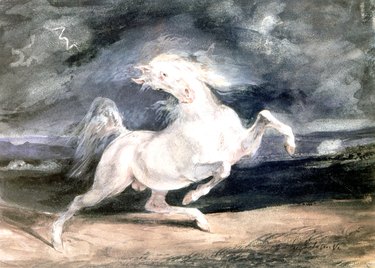
The Romantic period in art represents a significant shift in the methods of painting that took place in the 19th century. Unlike its predecessor, neoclassicism, Romantic art surrendered the pretenses of form and restraint for the sake of pursuing an intense emotional state called the sublime. While each painter had his own specific style and techniques, nearly all incorporated the same core characteristics of Romantic art.
The Essence of Infinite Longing
Video of the Day
One of the most distinctive characteristics of Romantic art is its frequent portrayal of bold, intense emotions. Where previous generations idolized restraint, Romantic painters chose subjects in the throes of anger, fear and grief to express what German writer E.T.A. Hoffman described as "infinite longing," writes professor Jonathan Martinez in his book "Art & Humanities." These ecstatic states, occasionally veering close to melodrama, are designed to evoke strong feelings of awe and passion in the viewer.
Video of the Day
The Natural and the Mythic
In Romantic painting, the background often played as big of a role as the subject in elevating emotional intensity. The term "romantic" was first popularly applied to painting in the 18th century as a way describing works that depicted scenes of wilderness and ruins. This affinity for the natural world remained a mainstay in Romantic art through the 19th century, as seen in the dramatic seascapes of British painter J.M.W. Turner's "The Shipwreck" (1805) and the brooding forests of German painter Carl Blechen's "The Woods Near Spandau" (1834). While the natural world was considered an ideal setting for Romantic artists searching for the sublime, several painters also turned to the supernatural. These artists depicted scenes from Greek and Norse mythology to capture some of their epic intensity; one such is British painter Henry Fuseli's "Thor Battering the Midgard Serpent" (1790).
Color as Energy
Some artists, such as French painter Eugene Delacroix, approached Romanticism as an opportunity to completely rethink the use of color in painting. Like music notes, Delacroix believed that colors had their own energy and ability to inspire different mental and emotional states. His painting "Massacre at Chios" (1824) shows the theory in action, with its bold contrast of the ornate, colorful costumes of the soldiers against a field of desolation colored in dismal grays and browns. Where a neoclassical painter might have used light to illuminate a heroic figure, the brightest areas in Delacroix's painting are victims suffering from fear and despair.
Art for the People
One of the goals of the Romantic movement was to return art to the public domain so that it was as accessible to a farmer as it was to a noble. Gone were the days of art produced exclusively for the tastes of elite and wealthy. Paintings such as "The Raft of the Medusa" (1818-1819) by French artist Theodore Gericault replaced the nymphs and satyrs of the Baroque sensibility with low-class peasants to express the tribulations of everyday people. Unlike neoclassical masterpieces -- which were often held behind locked doors -- Romantic paintings were frequently taken on tours through cities and villages so they were always in the public view.